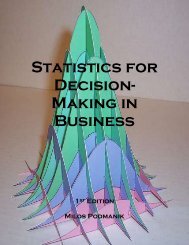Tutor Training Manual.indd - Chandler-Gilbert Community College
Tutor Training Manual.indd - Chandler-Gilbert Community College
Tutor Training Manual.indd - Chandler-Gilbert Community College
You also want an ePaper? Increase the reach of your titles
YUMPU automatically turns print PDFs into web optimized ePapers that Google loves.
20<br />
Students with Learning Disabilities<br />
What do Albert Einstein, Thomas Edison, Cher and Agatha Christie have in common<br />
with the fastest growing group on college campuses today They all have (had) learning<br />
disabilities (LD). Nearly one of every ten students (10%) in post-secondary education<br />
has this hidden disability. Some of these students were diagnosed when they were in<br />
elementary or secondary school and have therefore learned strategies in special education<br />
classes to increase their academic success. Others were not diagnosed until they reached<br />
college. For both groups, college presents special demands that can intensify the learning<br />
problems they have.<br />
Definition of Learning Disabilities<br />
Learning disabilities are not a visible disability like a physical impairment. Instead,<br />
they affect how a student of average or above average intelligence processes--takes in,<br />
retains and expresses--information. Like interference on the radio or a fuzzy TV picture,<br />
incoming or outgoing information may become scrambled as it travels between the eye,<br />
ear or skin, and the brain. This takes the form of a language-based and/or perceptual<br />
problem. Learning disabilities affect students, in varying degrees, in the areas of reading,<br />
writing, spelling, spoken language, mathematics, organization, time management and social<br />
interaction.<br />
Learning disabilities are believed to be caused by neurological deficits that affect the way<br />
students perceive, process, or express information. There is no clear list of symptoms<br />
that present themselves in all students with learning disabilities; each student has a<br />
different manifestation of their disability. As discussed above, by definition students with<br />
learning disabilities have average to above average intelligence and experience significant<br />
discrepancy between their intellectual aptitude and academic performance.<br />
Students with learning disabilities have fluctuating abilities in different areas. They also<br />
have good and bad days. Individuals with learning disabilities experience an uneven ability<br />
to learn resulting in achievement in some areas being superior to that in others. A student<br />
may have extreme difficulty organizing and writing a paper, yet he or she may excel at math.<br />
Another student may spell at a third grade level and have a severe disability in the area<br />
of spatial perceptions, which manifests itself as terrible clumsiness or carelessness with<br />
handwriting, yet excel at giving speeches.<br />
Because of the inconsistency associated with learning disabilities, it is easier to remember<br />
what disabilities are not included. A learning disability does not include the following:<br />
• Mental retardation<br />
• Emotional disturbances<br />
• Language deficiencies<br />
A learning disability is inconsistent. It may present problems on Mondays, but not on<br />
Tuesday. It may cause problems throughout grade school, seem to disappear during high<br />
school, and then resurface again in college. It may manifest itself in only one special<br />
academic area, such as math or foreign language.<br />
A learning disability is frustrating. Persons with learning disabilities often have to deal not<br />
only with functional limitations, but also with the frustration of having to “prove” that their<br />
disabilities are real.

















